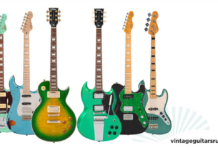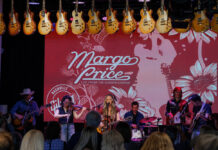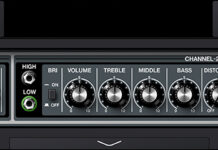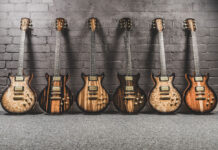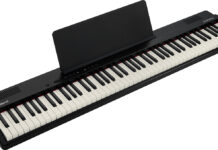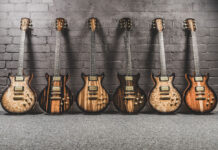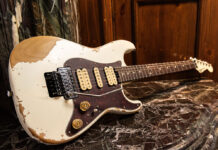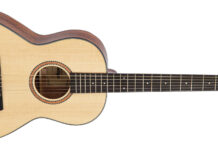22 Guitarists, Producers and Gear Makers Reveal Their Tone Secrets
Tone is the Holy Grail for all guitarists. But while Sir Galahad undertook the quest in solitude, it’s rather foolish for today’s guitarists to venture off alone.
After all, there are myriad tone junkies who have already made the quest, slain the dragon, grabbed the chalice, and discovered the secrets of great sound. All you have to do is follow in their footsteps.
So to help you with your quest for transcendent tone, we assembled a “Round Table” of 50 sonic knights—from famous guitarists and renowned repairmen to manufacturers and engineers—and asked them to share their tips, treatments, and methods. Happy hunting.
Visualize: Elliot Easton
When you’re attempting to come up with parts and cool sounds, envision the sound you want before you try to create it. I never pick up a guitar until I know exactly what I want to do.
Use the Room: George Martin, Producer
I’m a great believer in getting the sound right in the studio. If that works, then the rest of it is easy. A room is an instrument, and it affects the other instruments. If you understand what your guitar sound is like “in the raw,” you’ll have a much better idea of how it should be “cooked.”
Strip Down: Dave Cell Block, Cell Block 5
The old-school punk tone is raw and stripped down—there’s no candy-coated stuff—so stay away from pedals and gadgets. Get a Marshall head, crank it to 10, and plug in a Les Paul. I record with two Marshall half-stacks. One is in a small isolation booth for a compressed sound, and the other is set up in a hallway for natural reverb. The hall sound is brighter and cuts through the mix, while the room sound produces a fat bottom.
In the hall, we put a mic behind the cabinet to capture the rumble. When you stand onstage, you hear the cabinet rumbling and that sound should be on tape. Then, a mic is positioned right on the speaker for snap, and another mic is placed 5’ from the front of the cabinet to get the ambience. In the room, we just put one mic right on the speaker.”
Optimize Your Guitar: Terry McInturff, Terry C. McInturff Guitars
Experienced audio engineers know that it’s essential to have a good source sound to obtain great tones. So guitarists can ensure the best tone for any situation if their sound source—the guitar—is performing to its maximum potential. Locate an experienced luthier who can help you keep your guitar in great shape. Seek recommendations from fellow guitarists in your area, and pay a visit to the luthier’s shop to get a feel for the craftsperson. A luthier who understands your musical requirements and whose shop has a professional vibe and reputation is a good bet. Remember—you are seeking the ideal doctor for your precious guitar. Check references and trust your instincts.
Use Your Hands: Fareed Haque, session pro
You often can’t depend on amps or rigs for optimum tone production, so learn how to rely on your hands. But first, keep in mind that there is no such thing as “good” tone—the guitar is one of very few instruments that can produce many different tones. An expressive player can use these tones to make the guitar sing. Pick notes all over the neck and listen to how unique each note sounds. Then play one note and vary the tone by plucking closer to, and further away from, the bridge.
To vary attack, try picking harder with your pick flat on the string, and softer with the side of the pick. Also, pay attention to how your notes end. Play one note, cut it off suddenly, and then compare that tone with the sound produced when you gently mute the note. Cut notes off with your left hand, your right-hand palm, and your pick, and compare the different effects. You can make notes last longer by messing with the note as it dies away. A real intense, fast vibrato will make a note last longer. Try a classical up-and-down vibrato and a blues-approved side-to-side vibrato at different speeds to see which technique best produces the effect you want.
Feed Your Head: Steve Vai
Sounding better is mostly in your head. The next time you sit down to play, sit in silence for a few moments and try to imagine how you want to sound. I’m not referring so much to the amp settings or anything technical—I’m referring to the way your fingers hit the strings. Keep that audible image in your mind when you’re playing, and focus to achieve it. It’s also very important to record yourself and listen back with a critical ear. This way, you’ll be able to mold yourself around your own tastes, rather than someone else’s.
Use Tube Mics: Sharon Isbin
One of the wonderful features of tube microphones is warmth. Tube mics can be used to close-mic acoustic guitars to capture the instrument’s presence, but will not compromise the tone with the brittle high-end often produced by solid-state mics. On my latest release, Dreams of a World—Folk-Inspired Music for Guitar [Teldec Classics International], I used Neumann M149s to capture the lush ambience of the Teldec studio in Berlin. In addition to the close mic, we mounted two other M149s on 10’ poles placed 12’ apart. I was delighted with the clarity, warmth, and resonance that resulted—all of which complimented the sensuous beauty of the music.
Fab Feedback I: John Jorgenson, Hellecasters
One of the tones I often get asked about is the overdriven, controlled feedback sound on two Hellecaster’s cuts, “Passion” [from The Return of the Hellecasters] and “Son Becomes Father” [from Escape from Hollywood].
On both songs, I used a prototype G&L Comanche that Leo Fender had given me to test in 1989. The combination of the guitar’s Z-shaped pickups, maple body, and two-pivot tremolo made it extremely good for overdriven, saturated tones that would easily move into feedback an octave above the note being played. (This guitar would later be the inspiration for my Fender signature guitar.)
I selected the middle/bridge pickup combo, plugged into an old Ibanez Tube Screamer, and ran through the second channel of a Matchless SC30 combo. I cranked the channel volume to two o’clock and turned the master volume to 11 o’clock. This produced a tremendous amount of volume—which is an essential part of the tone. I positioned an AKG C414 about 2” from the speaker—padded down 10dB—and tilted the mic slightly off center from the cone.
The signal was then routed to a Neve 1066 preamp (with the EQ flat) and a Manley tube compressor. I sat very near the amp, and actually pushed the headstock into the cabinet to get sympathetic vibrations going through the neck for certain notes. This type of tone and feedback interaction would not be possible with the amp and player in different rooms, as the liveliness of the tone comes from the guitar reacting to the volume of the amp.
Mess Up Your Picks: Dan Erlewine, repairs columnist
Some of my favorite tones are produced with worn flatpicks. When a flatpick’s edge gets rough, it produces a wonderfully aggressive biting effect similar to a bow being drawn across violin strings. When I really want to make my strings sing, I reach for an old pick. You can reproduce this effect by sanding the pick edges with 220-grit sandpaper, but nothing beats natural pick wear. I’ll also use a common hole punch to create a hole in the center of the pick.
This keeps the pick from slipping, turning, or losing position as I’m playing—and I love the feel of my index finger touching the flesh of my thumb.
Don’t Read About It! Dave Navarro
Reading a magazine article never helped me play or sound better—playing helped me sound better. An hour or two of practicing in my room has always been more effective and productive than learning what kind of amp Carlos Santana uses.
Fab Feedback II: Steve Morse
One way to add interest to a ringing chord or long note is to have it feed back along with the note you’re playing—or even an upper harmonic of the note. To do this, you’ll need enough volume from the amp to resonate through the guitar body and its pickups. But the level doesn’t need to be deafening—the secret is not lots of volume, but determining the right distance between the speakers and the guitar.
Stand several steps away from the speaker with the input gain cranked—the volume doesn’t need to be any louder than usual—and select the bridge pickup on your guitar. Play each note on your sixth string for several seconds, being sure to cover the other strings with one of your hands so they don’t ring. Do the same thing on the fifth and fourth strings until you find notes that keep feeding back in a useable way—preferably feedback that sustains the note and changes to an upper octave or a fifth above. (Squealing, microphonic feedback means you’ve got way too much volume.)
Once you’ve identified a ringing note, move further away from the speaker to get a lower-pitch note to sound, and closer to get a higher note. Remember the spot, or mark it with a small piece of tape. I use this technique every time I play “Perfect Strangers” with Deep Purple so that I can get the D chords to sustain with feedback, and I also use it for the G chords in “Highway Star.”
Blend Amp Tones: John Connolly, Sevendust
Tone comes from three things that you can’t buy in a music store: your right hand, your left hand, and volume. If your tone is lacking, turn up your volume! (Your neighbors will love it.) In the studio, I run through two amps: a Marshall JCM 2000 TSL and a Marshall Valvestate 100-watt stereo chorus (with the chorus off).
The tube amp gives me warmth—which works great for taming the sharp mids of some digital effects—and the solid-state amp provides a very clippy, chunky, and tight low end. For a massively heavy low end, I’ll run my Rocktron Replifex one octave down and use a DigiTech Whammy to go two octaves down. When you hit the bottom with stacked octaves like that you really start moving some air—you have to be very careful how hard you pick when using this many octaves because a heavy hand will produce a muddy mess. I used this technique on Home to get the low G# one octave lower than the bass.
Follow the Song: Mike Turner, Our Lady Peace
The first concern of any guitarist should always be the song. The song will dictate the part, and the part will dictate the tone, so pay attention! After that, the most important things are to play in time, play in tune, and play musically. People tend to overlook these three simple things in the search for the ultimate tone. At some point in a tonal obsession, you become more of an engineer than a guitar player. You’re there to play guitar, so just use your ears and do it.
Compile Licks Reeves Gabrels, former David Bowie
At the start of a project, I like to make a DAT compilation of tones, sounds, riffs, and stuff that others might consider throwaway guitar junk. Then, if I feel a track needs a curveball, I’ll sample some stuff off the DAT, play it on a keyboard, and see if I can get that dog to hunt.
The opening riff for “Little Wonder” [from David Bowie’s Earthling] was exactly that: three E notes with different vibratos, played on a Parker guitar through a Mesa/Boogie V-Twin. The notes were sampled and played on a keyboard—but not in their original octaves. This made for a distinctive sound that hung more with the drum ’n’ bass vibe we were into back in ’96. Learning how to play that riff live was a real bitch—a helpful, rut-busting lesson. Sampling yourself is a great way to learn about your playing.
Punch In Marty Friedman
On “Time, the Beginning” [from Risk], I struck a note before the machine was recording, and punched in and out of Record before I let go of the note. Then I rewound the tape past the note that was just recorded, held the next note, and punched it in so that it overlapped the previously recorded note. I continued until I had a long string of notes with no attack that seemed to connect seamlessly and beautifully. This technique is great for creating backing guitar parts that add a spooky, lyrical guitar vibe to a song.
Don’t Over-Refine David Torn
While it’s valuable and necessary to go through phases where you attempt to emulate your favorite player’s tone, if you spend an inordinate amount of time over-refining your sound in order to precisely emulate someone else’s, it’s likely that you’ll wind up scraping away your most personalized sonic scars, blemishes, bumps, and warts. In the long run, those deleted bits might have been your defining musical personality traits.
In other words: If it’s broke—but you think it could be good—don’t fix it! Your guitar tone plays a relational role with your music, so don’t be afraid to use thin, weedy, grotty, bulbous, degraded, viscous, harsh, sickly sweet tones if they suit the overall gestalt of the music. Play (and process) from your heart, and use any available brain waves as support.
Find the Right Partner Leni Stern
First, find a guitar that you love. One that sounds great with and without an amp, and that makes you feel like playing forever. Second, learn one of J.S. Bach’s violin sonatas and play it really legato—let the notes overlap and find fingerings that make it possible to produce a continuous flow of sound. Finally, start your day by playing one note and making it sustain as long as possible. Use vibrato—like sax players and singers—until you start hearing a sound that is yours alone.
Swap Preamp Tubes Mark Baier, Victoria Amplifier Co.
While most guitarists are aware of the influence that power tubes have on amplifier performance, many overlook the importance of preamp tubes. Proper preamp tube selection is critical to bringing out the best in your amp. Take some time and acquaint yourself with the sonic nuances of different brands of tubes in the same tube family. For instance, there are dozens of different brands and vintages of 12AX7s available.
By learning the sonic characteristics of these variants, you will be able to better calibrate your amplifier for your specific needs. Often, swapping the modern Russian or Chinese 12AX7s found in most new amps with quality NOS (new, old stock) varieties can turn a bland-sounding amp into something much more musical and intuitive. Start by swapping tubes in one socket only—preferably the first input tube—and listen carefully to a familiar lick or chord progression.
You’ll be surprised at the contribution this one tube can make. And don’t overlook the tubes in your rack gear or tube-driven footpedals. The next time you get a jones to spend $300 for a pair of RCA Blackplates or Mullard EL34s, remember the same money can buy a dozen or more quality NOS “peanut” tubes.
Kill the Reverb Brent Mason, session pro
One thing live players have a tough time doing when they get into the studio is turning off the reverb. (I had to go to reverbaholics anonymous!) Reverb can mask your sound so that it doesn’t cut through the track enough to really pop—and once you track with reverb, it can’t be removed. Your parts will jump out a lot better if you cut them dry.
Flip the Pick Craig Chaquico
Use the round edge, instead of the pointy part of your pick, to get a fatter tone for solos. This is the opposite of getting high, harmonic squeals from the pick and finger, and the technique works best with heavy-gauge picks and strings. (I prefer the sound of Jim Dunlop Polycarbonate Gel picks and Dean Markley medium-gauge Blue Steel Cryogenic strings.)
You can experiment with finding different sweet spots on the pick, and for a little more attack, you can score little grooves in the rounded part of the pick with a file or razor blade. I’ve used this pick trick on both electric and acoustic solos, but the technique can really be heard on the solo for “Jane” [from Jefferson Starship’s Freedom at Point Zero].
Get Your Own Power Eric Johnson
For optimum amp tone onstage, plug your amp into your own AC outlet. Plugging into common power strips with other band members will be destructive to the even harmonics of your amp sound—especially if synths and computer gear are sharing the strip. For safety reasons, however, it’s still best to stay on the same circuit as the other players.
Get Weird Buckethead
In the track “Jowls” [from Monsters and Robots], the “chandelier” scrape at the beginning of the song is achieved with the trusty Roland SE-50 set to produce two pitches descending and two pitches ascending, thus creating the sound of four minor seconds. No delay was used, the level of harmony was 100 percent on each note, and the volume levels of the actual note and the processed harmonies were equal. Save me the slunk!
Source: www.guitarworld.com


